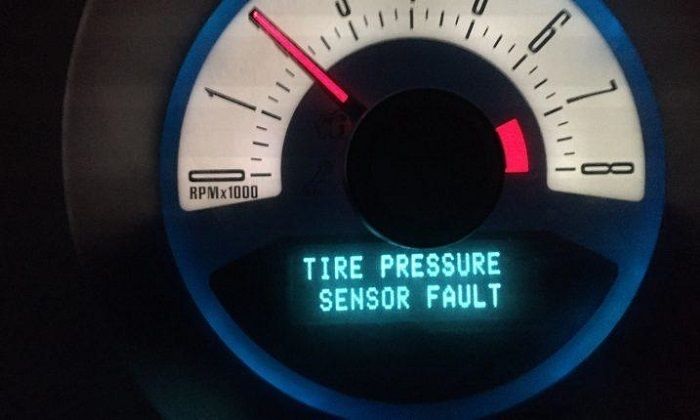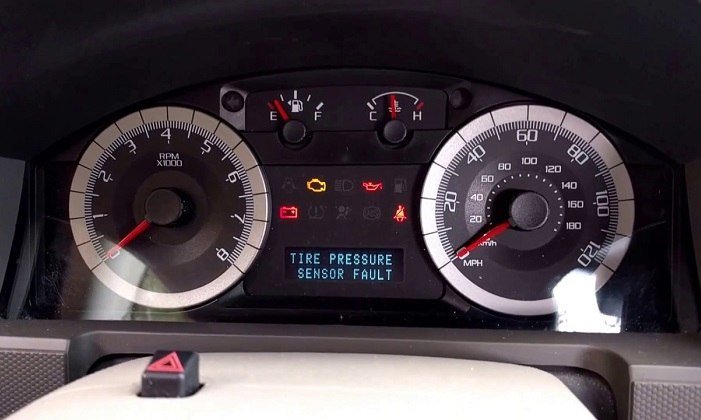by Joshua Thomas
When the "tire pressure sensor fault" message suddenly pops up on your instrument cluster, you can easily get confused about what to do if you do not know what it means.
This message is quite common for modern vehicles with more advanced tire pressure management system. And while it is an indication there is a problem that needs to be resolved, it is not necessarily something that should cause panic.
There are different things that you need to understand about this error to determine how best to deal with it, and how urgently you need to solve this common issue. Below we highlight the most important things you need to know.
Contents

Modern vehicles are fitted with a tire pressure sensor which is a small computer inside each tire, and it is designed to alert motorists when they have under or over-inflated tires. In the USA, these sensors have been a mandatory requirement for vehicles since 2007.
When you have a problem with the tire pressure management system, you will get a tire pressure sensor fault message. This error code will come up when you either have a faulty TPMS or the air in the tires is either too high or too low.
For some vehicles with more advanced computer systems, you will get the “tire pressure sensor fault” message on the dashboard while for others it will be a lighted symbol.
This symbol or light is often bright yellow and will be an exclamation mark (!) encased in a U-shaped symbol. And this symbol should be a sign that you have to check the tires.

Like any other vehicle problem, a tire pressure sensor fault will come with different signs and symptoms that you need to watch out for in case you do not get the message or even just miss it in case your dashboard lights are faulty. Here are some of the most common ones.
When your tires are improperly inflated or when one or more are under or over-inflated, the vehicle tends to consume more fuel than usual.
Under-inflated tires result in a drag which forces the engine to burn up more fuel than usual to ensure the vehicle keeps moving smoothly.
Hence, when you notice that you have a higher fuel economy than usual, you need to check your tire pressure sensor system.
A problem with any of the sensors in your vehicle will often cause the check engine light to come on. This light also often indicates a problem with the vehicle’s computer and a tire pressure sensor fault is one of the problems that it is likely to pick out.
But, given the myriad of issues that can cause this light to come on, it is not always a reliable symptom of this issue, and so to be more certain, you need to combine it with at least one other symptom.
Read More: How to Reset Check Engine Light
Under or over-inflation of tires is one of the most common causes of uneven wear. Hence, if you find that one of the tires is wearing out faster than the others, this is a symptom of the tire pressure sensor fault, and you do not need to wait to see the light illuminate on the dashboard.
Given that different vehicles will be driven in different terrains and conditions, various things can lead to a tire pressure sensor fault just like with most other vehicle issues. However, here are some of the most common ones.
Low tire pressure is the main reason you will get the tire pressure sensor fault because this is what the sensors have been built to detect.
The sensors are fitted on each of the tires, and when one detects that there is less pressure in the tires, it will send the message to the control module that is in charge of the tire pressure management system.
This module then alerts the vehicle's computer that there is an issue with tire inflation, and hence triggering the message or turning on of the light on your dashboard.
Sometimes your tires will all be adequately inflated and not have any issue and you still get the tire pressure sensor fault light. In such cases, the problem might be a faulty TPMS system.
Like any other system such as the brake or transmission system, the TPMS will consist of different parts and components which are prone to wear and tear, corrosion and accidental damage.
If any of the components in the system is faulty, you will also get the alert on your dashboard, and in such instances, it is an indication that the system is not functioning optimally
Tire pressure sensors that have reached the end of their service life are also a common cause of the tire pressure sensor fault error.
Most tire pressure sensors will have batteries that should last at least 5 years depending on how often the car is driven. When the battery drains out, this is also often the end of the service life for the sensors.
Also, the pressure sensors will fail due to corrosion in the valve stem, and this is more so for those that have aluminum sensors because unlike rubber ones, they are highly prone to corrosion.
Sometimes the only reason you will have an issue with your tire pressure sensors is that you have a wiring fault.
Wiring fault often occurs during tire servicing where inexperienced mechanics tend to mix up different wires and cables which often results in malfunctions.
Although quite rare, short-circuiting of the wires that power the TPMS can also cause it to misbehave and result in a tire pressure fault error.

How you deal with the tire pressure sensor fault will largely depend on the underlying cause, and hence the need to first identify the cause when you notice the light or message come on.
Also, sometimes you can fix the error on your own at home, but in some instances, you will need professional help. Overall, here are the main ways to deal with the issue.
One of the easiest and also most effective ways to fix the problem will be to inflate the tires properly. And you will only need to check the tires that you have for the recommended inflation.
The best idea here will be to start with all the tires deflated and then inflate them one by one to the recommended PSI, which is typically written on the side walls.
Also, it is a great idea to inflate them a little bit more than what is written in the label as they are likely to lose some air when driving and even you are removing the tire inflator.
Some vehicle models will include a button or switch for resetting the TPMS, which means they will give you a very easy time when it comes to dealing with tire pressure sensor fault.
Dealing with this problem will be as easy as pushing the reset button, but some models will require you to follow a more complicated process. However, the vehicle's manual should provide adequate information on how to do the reset.
And note that for vehicles that use an indirect system the reset should be done using a magnet or OBD 2 scanner.
Each of the wheels on your vehicle will have a transponder whose location will change when the wheels are rotated.
When you have the wheels rotated, the TPMS will also have to learn the new locations. In some instances, this learning period may cause the tire pressure sensor fault to come one.
And so the best ways to ensure this does not happen will be to recalibrate the transponders on your wheels after every rotation. Also, it will be a great idea to change the valve stems when rotating your wheels or replacing them with new ones if they act as the pressure sensors.
The car's onboard computer checks the information from the different sensors on your vehicle and decides what to do with it. Hence, if you can somehow make the computer forget some of this information relating to the tire sensors, you can clear the tire pressure sensor fault light.
One of the most effective ways of making your vehicle’s computer forget is by disconnecting the battery terminals.
To do this, you should pop the hood and disconnect the negative terminal, switch on the vehicle and press horn for a few seconds to drain out any remaining power in the system, and then wait for a while before reconnecting the battery.
The other method of dealing with the tire pressure sensor fault will be to scan and clear the underlying error codes. For this, you will need an OBD 2 scanner.
The process here is quite straightforward as you will only need to connect the OBD 2 scanner to your vehicle, and then scan the computer to identify the recorded errors and clear them.
When you get the tire pressure sensor fault message or warning light, this is a sign that you have some issues with your tire pressure management system that needs to be checked. And these issues can range from faulty sensors to wiring faults.
The good news is that regardless of the underlying cause, this is a relatively easy problem to fix, and the possible fixes can be as simple as inflating your tires properly and clearing the error code with an OBD 2 scanner.
With that said, regular inspection of the tires and the TPMS system will provide an effective way of preventing this fault.
Sources
 |
 |
 |
 |

About Joshua Thomas
Joshua Thomas just simply loves cars and willing to work on them whenever there's chance... sometimes for free.
He started CarCareTotal back in 2017 from the advices of total strangers who witnessed his amazing skills in car repairs here and there.
His goal with this creation is to help car owners better learn how to maintain and repair their cars; as such, the site would cover alot of areas: troubleshooting, product recommendations, tips & tricks.
Joshua received Bachelor of Science in Mechanical Engineering at San Diego State University.
Just Car Care